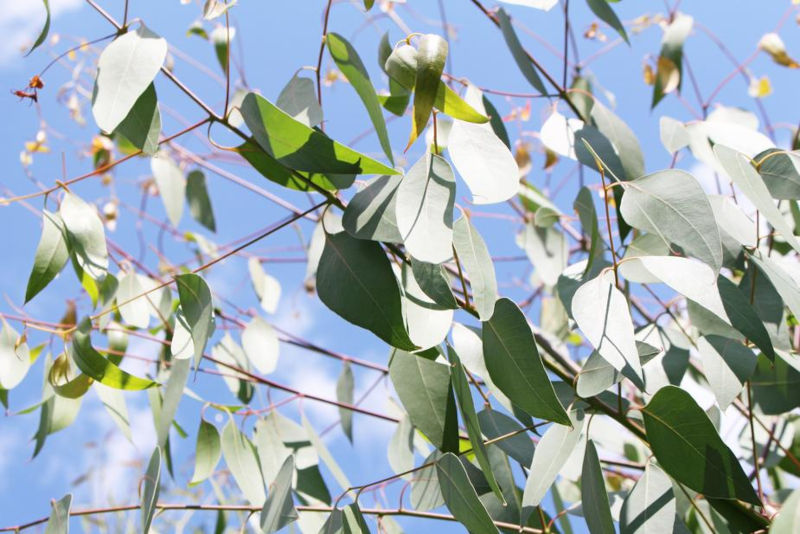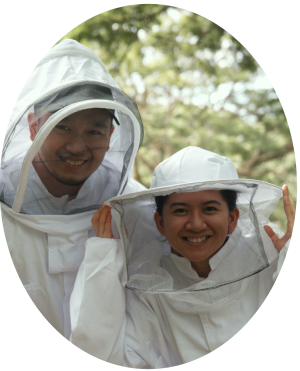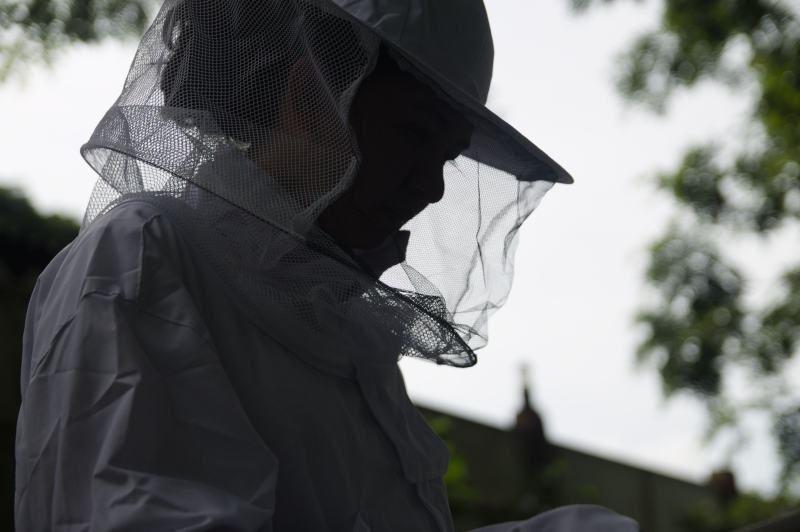Rather than the typical list of ways to avoid bee stings, we’ve ranked the most common suggestions according to their effectiveness for the backyard beekeeper. All are important steps that reduce the risk of bee stings. For the beginner beekeeper, this is the order you should want to pay attention to.
Table of Contents
1. Have a calm demeanor
Most seasoned beekeepers will agree that a calm demeanor is the number one deterrent for getting stung by bees.
Bees are docile creatures and prefer not to sting. In fact, honey bees only sting as a defensive mechanism, never as an offensive attack. And that means they usually ignore humans when foraging far from their hive.
But as a beekeeper who’ll probably be around beehives more than the average person, a calm demeanor goes a long way. Here are a few key points you’ll want to bear in mind.
- Do not swat at bees
- Avoid crushing them when moving frames
- Do not drop the frames
- Have slow and intentional movements
This calmness is even considered the “secret” by beekeepers who don’t wear protective gear. That brings us nicely to the next best way to avoid bee stings as a beekeeper.
2. Wear the right clothes
Protective gear helps a lot, there’s no doubting that. But the reason this is number two is that even beekeepers with full suits get stung.
When selecting your gear, the key is choosing loose-fitting bee suits. You probably should go one size larger. Honey bee stingers can penetrate thick clothing, such as jeans, so it’s best to wear clothes that don’t stick to your skin. Also, consider wearing a cap so that the veil is off of your face.
But how about gloves? This is like the chicken-and-egg conundrum. Gloves restrict your sense of touch and you increase your chances of hurting the bees. Remember, they are defensive insects and attack when provoked. But as a beginner beekeeper, are you more likely to inadvertently crush a bee anyway? Probably?
There’s no absolute answer to this. But what’s certain is wearing protective gear greatly reduces bee stings.
3. Reduce the odor you emit
The third best way to avoid getting stung by honey bees, at least in our opinion, is to reduce the smell you release. The effect on bees is very similar to number 4 below, but this ranks ahead for reasons we’ll explain later.
Honey bees are very sensitive to smell and have 170 odorant receptors. These receptors not only help them spot flowers they like, but they also help bees use smell signals through a chemical called pheromone. Pheromones alter the behavior of bees, from maintaining the hive, mating, swarming, and yes, stinging.
(Related: 9 Superhuman Facts About Honey Bees, Trivia with Infographic)
Nothing personal, but some bees might dislike the foul smell expelled by humans from not taking regular baths. Likewise, strong perfumes may offend them.
To be clear, honey bees are not attracted to human smell but strong odors might trigger them. It’s best to remain odorless then, just to stay on the safe side.
4. Using a smoker helps a lot
I’ve already mentioned how bees are very sensitive to smell. Puffing some smoke reduces the risk of bee stings. Despite being similar in effect (i.e., curtails smell), this ranks after number three simply because a few proponents consider this an inhumane tactic. (But that’s certainly arguable.)
Whether you’re a proponent or not remains to be your choice. To me though, this trick is tantamount to training dogs with the use of outside elements. Smoke is a natural occurrence, nothing like pesticides.
Seasoned beekeepers and some scientists hypothesize varied reasons why smoking helps. One is that smoking tricks the bees into thinking there’s real fire. They then stock on honey and are focused on things other than the beekeeper — which is why stinging is less likely to occur. Another reason that’s mentioned a lot is smoking blocks the honey bees’ sensitive smell or odorant receptors. The blocked pheromones mean bees are less likely to sting.
5. Inspect when it’s the right time and weather
Schedule your inspections during the day (i.e., avoid inspections at night) and/or when the weather is favorable. Try not to visit the hive when it’s raining or during thunderstorms.
There’s a simple reason. When it’s sunny and daytime, most worker bees are out and about foraging and scouting. The lesser bees mean a lesser chance of getting stung. They’re also less protective as a unit, probably because incursions are expected during the day.
To remember this, it’s been said how bees and humans have similar temperaments. Humans are generally happier when it’s sunny. Whether that’s true or not, it’s a neat trick to remember. Schedule your visits when your honey bees are happier, not when it’s dark, cold, and raining.
The reason this ranks in the middle is that we can’t control the weather.
(A little tidbit. Our first honey farm visit was on a rainy day. My wife and I weren’t stung despite the rain and lack of protective gear. I guess it shows how docile and gentle creatures honey bees really are.)

6. Wear light colors
Here’s another easy one to follow: Wear light colors. Assuming your bee suit hasn’t arrived yet, try selecting light-colored shirts or jackets. (And yes, that is why bee suits are white.)
Honey bees have evolved to defend the hive against large animals like bears. They associate dark colors with these adversaries, so it’s best to wear white or some other light color.

7. Avoid staying in front of the hive
Although honey bees require very little space, they nevertheless shoot straight out of the entry and exit points. Staying out of the takeoff zone is another way you can avoid bee stings.
Admittedly, this is a supporting point to the previous tips. If they want to get to you, bees can get to you no matter what side of the hive you’re on. That said, this is a simple step to follow. Stay out of the way and you might just avoid bee stings.
8. More exposure means familiarity
Bees are smart, but you may have noticed this by now. They remember colors as well as visual cues on your face. In a way, they remember you. The more you care for them, the less likely they’re going to sting you.
But this is a double-edged sword. If you’ve just had a bad encounter with them, it’s probably best to reschedule your visit for another day. Let them cool down a bit. The good thing though is they’re more forgiving than humans. Don’t give up, keep trying.
What to do when a bee stings you
In the unfortunate incident that a bee does sting you, it is important to remain calm, walk away, and do the following steps.
- Remove the stinger right away. Avoid using your fingers or tweezers as you might end up squeezing the venom sack that’s left. More venom means more irritation. Try using a blunt object to scrape the stinger off.
- Take an antihistamine to relieve the irritation and pain. You can also apply soothing balms or oils to reduce the itchiness.
- Apply a cold compress. This also helps alleviate the irritation.
- Elevate the affected area to reduce swelling.
See the American Academy of Dermatology Association’s guide on how to treat a bee sting.
Also, see Healthline’s 6 home remedies for bee stings.
Conclusion
There are many ways to avoid bee stings as a beginner beekeeper. It starts with being calm. Then it’s about having the right gear. Next is about caring for your bees at the right time. And finally, it’s about familiarity with your bees.
Honey bees are actually very much like pet dogs. (Maybe dogs are easier for most people to understand?) Dogs don’t bite when you’re calm, some are friendlier than others, and, apparently, dogs remember us.
This ranking is an opinion that could definitely go either way. Do you agree with this list? Is there anything I missed? Let the community know in the comment section below. Stay safe and happy beekeeping!

Honey Farm Starter documents our journey from novices to (hopefully) experts. If you’re feeling a bit intimated by all big words and don’t know where to start, this place is for you. We are Dan & Deanne, and our hope is to create a resource that’s as encouraging as possible for the everyday backyard beekeeper.

